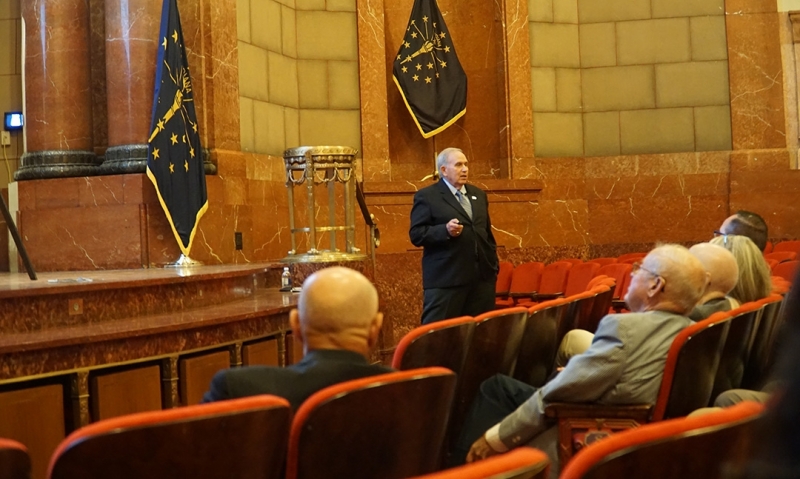
U.S. role in Somalia: 'I think we had to do it'
When U.S. Army Lt. Gen. Thomas Montgomery arrived in Mogadishu, Somalia, in early 1993, he said the smell of death was in the air because of the starvation of babies, children and people – warlords were using food and other resources for their own causes. His mission as commander of U.S. Forces and deputy commander of the United Nations Forces in Somalia was to make sure humanitarian relief got to the people who needed it through the setup of feeding stations. And to disarm the Somalis.
After 13 months in Somalia, Montgomery witnessed the success of the humanitarian efforts, but also witnessed the lives of American soldiers claimed during the Battle of Mogadishu, and ultimately led efforts to rescue the Army Rangers and Delta Force with help from the U.S. Army's 10th Mountain Division, the Pakistanis and Malaysians.
Montgomery, an Indiana native who retired from the Army after 34 years of honorable service that earned him both the Silver and Bronze Star, shared his story to an audience at the Indiana War Memorial in Indianapolis on May 18.
“It very quickly became apparent that nobody is going to disarm Somalia. Nobody is going to disarm Somalia today either,” Montgomery said. “But what people forget is that it was a hugely successful humanitarian effort. Hundreds of thousands of Somalis survived because (the U.S.) and other United Nations did what we did.”
He showed the audience images of a feeding station with children and shared that while visiting one a young child ran over to him and put her arms around his leg and held on. He picked her up and held her. “That baby knew what that (U.S.) uniform meant. And she knew what it meant for them to survive over there.”
Throughout the humanitarian efforts, resistance from the warlords intensified and Montgomery became involved in a third mission that occurred on Oct. 3, 1993, in Mogadishu. That Battle of Mogadishu became known as the Battle of Black Hawk Down, and inspired the award-winning 2001 film. The Task Force Ranger and Delta Force had a mission to capture Somali warlord Mohamed Aidid and his allies, but they were met with strong resistance. “Every Somalian grabbed his gun, RPG, grenade … they came to fight,” Montgomery said.
During the operation, two Black Hawk helicopters were shot down by RPGs. Some wounded survivors were able to evacuate, but others remained at the crash site and were isolated. The battle continued throughout the night until the following morning when a rescue mission was underway.
Over a radio Montgomery could hear the battle going down and the banter from the soldiers, and then could hear that the forces were in trouble. “(The Rangers/Delta Force) were in danger and being overrun. I had to put a plan together. The relief became the second part of Black Hawk Down.” However, Montgomery didn’t have enough strength in armor or heavy forces. So he called both the Pakistani and Malaysian commanders to help rescue the soldiers who were in duress. Each one said, “’Yes, sir.’ There was no resistance; we were all soldiers,” Montgomery said. “We were doing everything we needed to support each other.”
The Pakistanis and Malaysians supplied armored tanks and troops. They followed in the 10th Mountain Division to rescue the Rangers and Delta Force. “And the Battle of Black Hawk Down is over,” Montgomery said.
The battle resulted in more than 70 U.S. wounded and 18 casualties, which included Delta Force snipers Gary Gordon and Randy Shughart, who were posthumously awarded the Medal of Honor for their heroic actions. Pilot Michael Durant was captured but later released. Montgomery said that while "Black Hawk Down" is a great war movie that provides a realistic depiction of the ferocity of the battle and valor of the Rangers and Delta Force, it’s about 60 percent accurate as it does not depict the rescue force of the 10th Mountain Division. And many people don’t know that a Malaysian solider died during the battle to save American soldiers.
“I'm very proud of the Malaysian and the Pakistani soldiers that were a part of (the mission), and I am enormously proud of the 10th Mountain Division who got very little recognition,” Montgomery said.
Following the battle, Montgomery received an ample supply of armored vehicles and stayed in Mogadishu for another six months to command the Quick Reaction Force. He departed for home in March 1994, and showed an image of it to the audience. He said it was the first time he could relax after not sleeping a single night through during his time in Somalia. "Because you're always waiting for the next thing to happen," he said.
However, when questioned whether or not the United States should have been over in Somalia, Montgomery said, “I think we had to do it. The humanitarian part of this was very important. We did a good service and a good job.”
